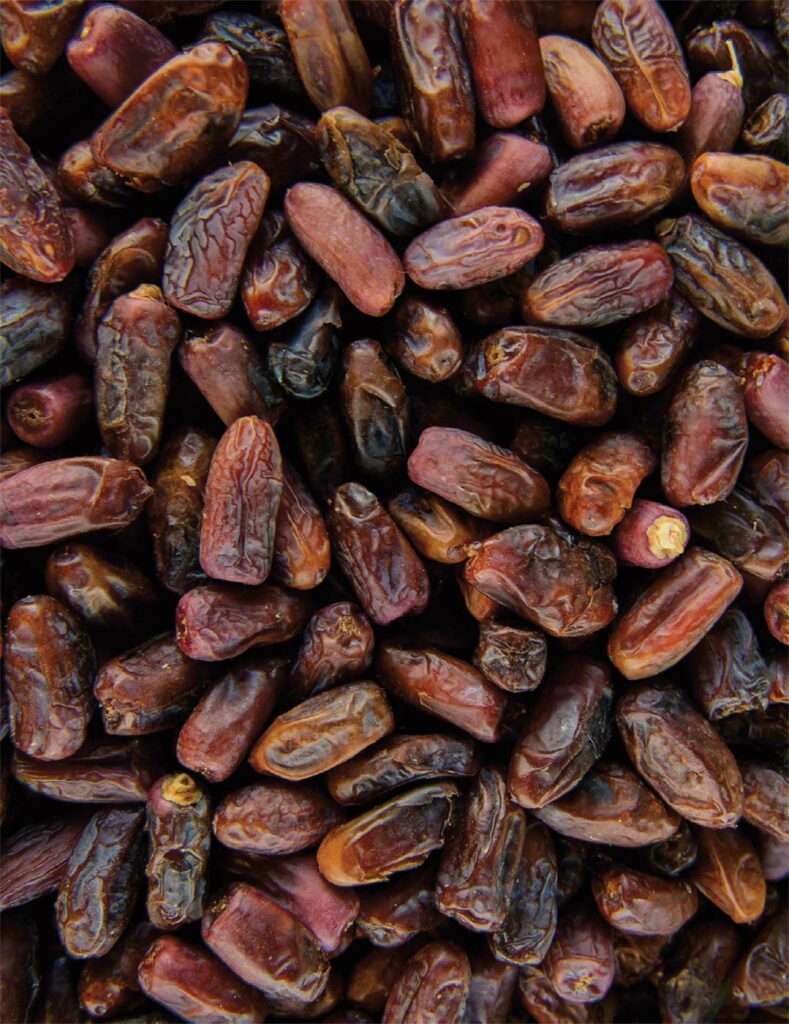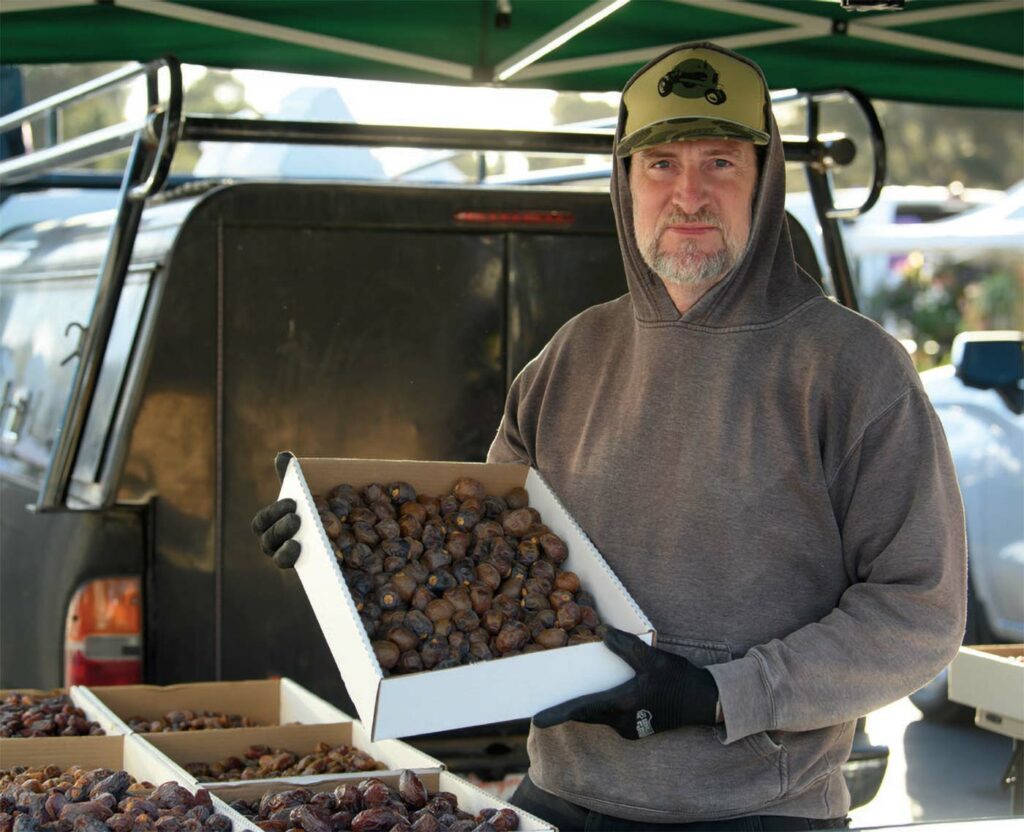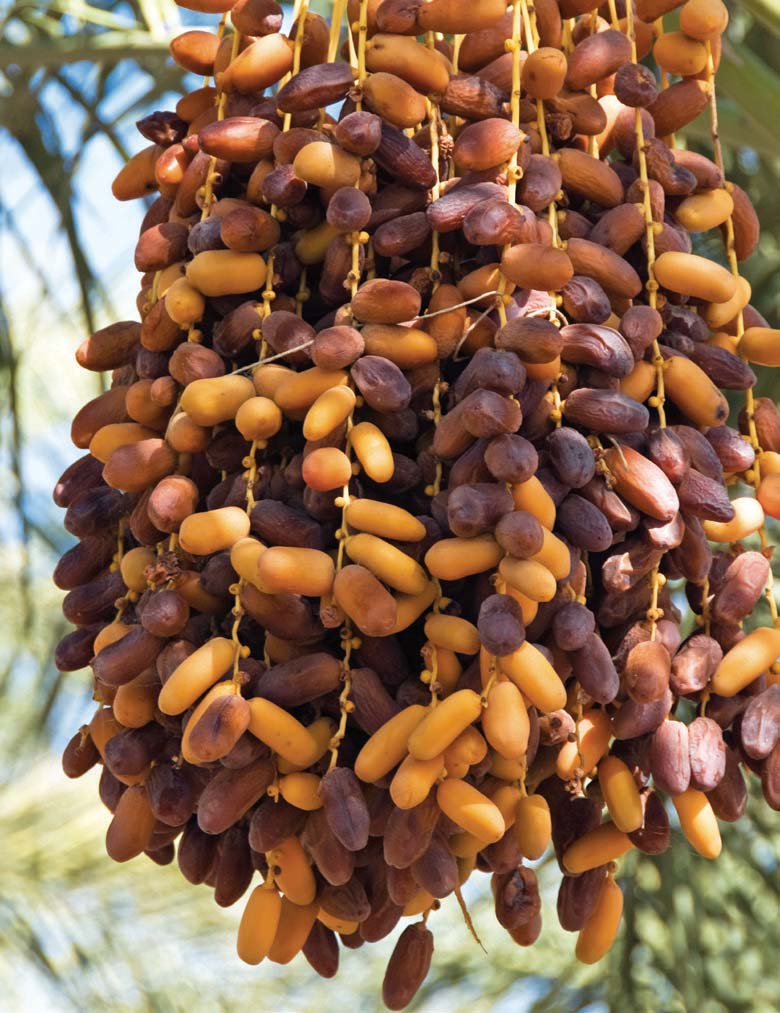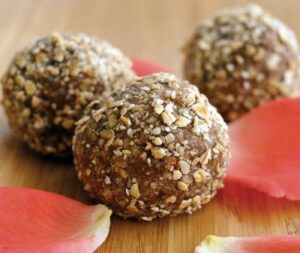
This ancient, versatile fruit comes in a variety of flavors and textures suited to both sweet and savory preparations
PHOTOGRAPHY BY MICHAEL TROUTMAN
As a kid growing up in Southern California, we made frequent visits to my grandparents’ place in Yucca Valley, located in the high desert near Palm Springs. It was a tradition to make a pit stop in Cabezon on the way, to grab a cooling, delicious date shake at Hadley Fruit Orchards.
Hadley’s has been an iconic roadside destination since 1931. Because date palms are cultivated in the region, the company has featured them in milkshakes. The sweet, creamy libation—essentially a vanilla shake augmented with soft, chewy dates and a dash of cinnamon—was invented in 1930 by Russell Nicoll at his Valerie Jean Date Shop in nearby Thermal. Soon, competitors, including Hadley, began offering their own date shakes, which today remain a regional specialty.
AN ILLUSTRIOUS HISTORY
The date palm, Phoenix dactylifera, is a flowering, fruiting tree that includes 19 different wild species. Dates are native to the Fertile Crescent, where fossil records show date palms have existed for over 50 million years. Dates have been cultivated in the Middle East for 200,000 years, making them one of the world’s first agricultural crops. Date palms tolerate hot, arid climates and poor soil, but “they love surface water and require consistent irrigation to produce the highest quality fruit,” says Darryl Gunderson, Central Coast regional sales representative for Thermal’s Flying Disc Ranch.
Dates, which are high in fiber, minerals and antioxidants, came to play an important role in the economy, religion and cultural heritage of the Middle East. The fruits symbolize fertility and prosperity, and are often served to welcome guests, or gifted during religious holidays and special occasions.
While the Middle East and North Africa produce and consume the most dates in the world, the Coachella Valley has garnered a reputation for high-quality dates like those grown at Flying Disc Ranch, which sells some of its 20 different varieties at farmers markets in Monterey, Santa Cruz and the San Francisco Bay area. “Flying Disc Ranch grows one of the largest collections of commercially available dates in the United States,” says Gunderson.
Flying Disc founder Robert Lower began planting date palms on his 10-acre property in 1979. A practitioner of permaculture, a regenerative farming method that works in harmony with natural ecosystems, Lower interplanted his palms with 10 different varieties of citrus, as well as mangos, guavas, figs and aloe vera.
This mixed food forest keeps the date canopy cooler and yields a “greener” soil. As a result, Flying Disc dates have more moisture and minerals, and flavor, and the canopy also provides a home for beneficial insects as well as owls, bats and falcons. The fruit grows in clusters, with several hundred dates per bunch. While quite pest resistant, the date clusters do require thinning and must be covered with a bag during ripening to protect them from birds and other animals.
Date cultivation is labor intensive, and date palms yield a single harvest per year worldwide, from late August through early November, says Gunderson, which account for the fruit’s higher price point. It can take up to a decade for a tree to yield commercial harvest, and the palms are dioecious, meaning male trees are required to pollinate the flowers on the female trees. Lower buys the pollen for his all-female plantation and pollinates the 100-foot trees by hand with the help of giant ladders.
“Date nuances on the palate are more diverse than practically any other fruit, and flavor wise, they’re similar in complexity to wine.”

HOW TO EAT
Dates differ in flavor and texture, which accounts for the versatility of the fruit. They may variously be used in sweet as well as savory applications, from out-of-hand snacking and confections to beverages and tagines.
“Date nuances on the palate are more diverse than practically any other fruit, and flavor wise, they’re similar in complexity to wine, says Gunderson.
In the Middle East dates are also made into vinegar, syrup and an effervescent juice, which is used for special religious occasions such as Ramadan. In Islamic countries, it’s also tradition to break a fast with a date.
“Most people are familiar with the medjool date because it’s historically been one of the most widely planted and available varieties,” says Gunderson. “Its robust flavor, agreeable texture and durability in transit and storage have contributed to its market dominance, but there are hundreds of named varieties, each with their own distinctive character of sweetness, texture and finish flavor. If you don’t like dates because you’ve only tried one or two varieties, I guarantee there’s one out there you’ll love.”
Fresh dates can be made into date syrup, stuffed with cheese and wrapped in bacon, pickled, used as the base for healthy energy balls, added to granola, tossed into smoothies, dipped in tahini, stuffed with nut butter, marzipan, whole almonds and candied orange or lemon peel, sprinkled into salads, made into a chutney, added to the top of a homemade pizza, and blended with olives for an excellent tapenade for a sandwich. Date nut bread is popular on a charcuterie spread or as a holiday treat. Anything savory a fig can do, a date can do with more added sweetness.
Dates complement meat (think sliced dates and red onions alongside a steak), and lamb tagines are often cooked with dates. Gunderson makes a delicious pickled date relish that brings sweetness, spice and brightness to any dish.
To prepare, combine chopped dates, raw garlic, hot peppers (with or without the seeds, depending on how spicy you like it), oregano, cumin and salt to taste. Cover in white vinegar. This can be refrigerator pickled by letting it sit for a week, or it can be preserved to be shelf stable.
I love how dates can satisfy a sweet tooth, be part of a savory dish and also an appetizer or added to a cheese plate. Be sure to pick some up at the farmers market this winter and incorporate them into your holiday spread.

IT’S A DATE
In addition to ripe fruit, Flying Disc Ranch sells young date leaves and flowers in the spring, when the trees are pruned. These are a florist’s dream; they dry beautifully and add texture and flair to floral arrangements. The varieties below will also be offered this winter at the Downtown Santa Cruz Farmers Market, the Del Monte Farmers Market in Monterey and Elroy’s Fine Foods, also in Monterey.
Medjool: The largest, sweetest variety, with a rich, molasses flavor.
Deglet Noor: A thinner, drier date with a buttery flavor, good for baking, backpacking and granola.
Dayri: A dark, soft, sticky date with a molasses flavor. Ideal for snacking, cheese plates, desserts and beverages.
Amber: A mild variety with a sweet potato flavor.
Zahidi: The least sweet variety, with a chewy texture and honey-apricot flavor. Try them in savory dishes or baked goods.
Khadrawi: “Nature’s Milk Dud,” as Gunderson describes, with a flavor and texture reminiscent of caramel candy.
Ciré: Chewy, luscious and sweet, with butterscotch candy notes. Use for confections or savory dishes.
Thori: The driest variety with a grainy finish Honey Nut Cheerio-like flavor. Excellent on cheese plates or snacking.
Barhi: The softest, sweetest variety sold by the ranch, with a melt-in-your-mouth quality and notes of brown sugar. The ranch also sells young barhis, which are yellow and sweet, with a firm texture ideal for tossing in salads.

About the author
Jamie Collins is the owner of Serendipity Farms and has been growing organic row crops at the mouth of Carmel Valley since 2001. She distributes her produce through a CSA, u-picks and farmers’ markets.
- Jamie Collinshttps://www.ediblemontereybay.com/author/jcollins/
- Jamie Collinshttps://www.ediblemontereybay.com/author/jcollins/
- Jamie Collinshttps://www.ediblemontereybay.com/author/jcollins/
- Jamie Collinshttps://www.ediblemontereybay.com/author/jcollins/



